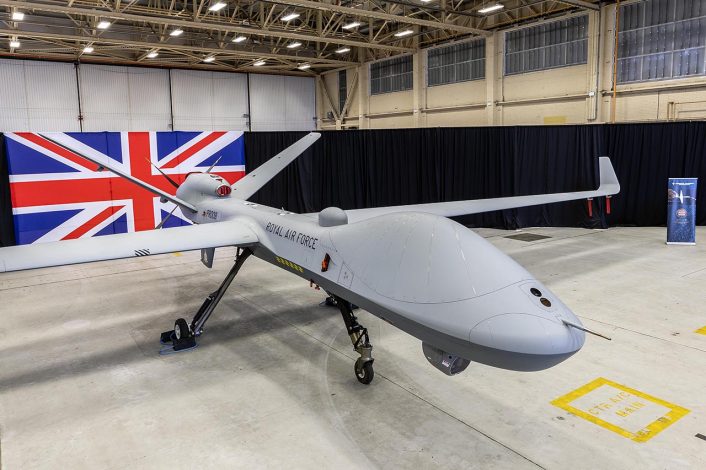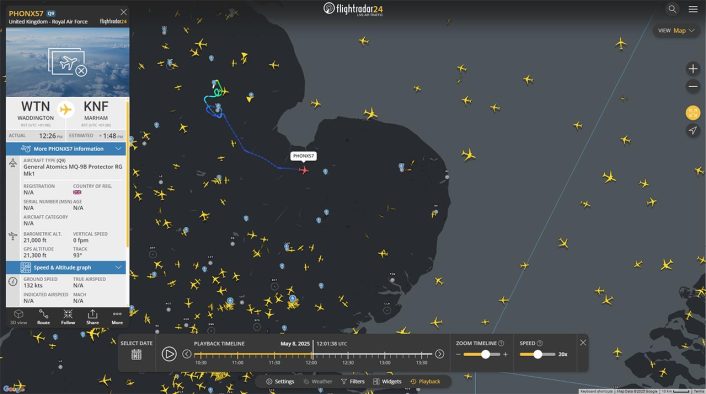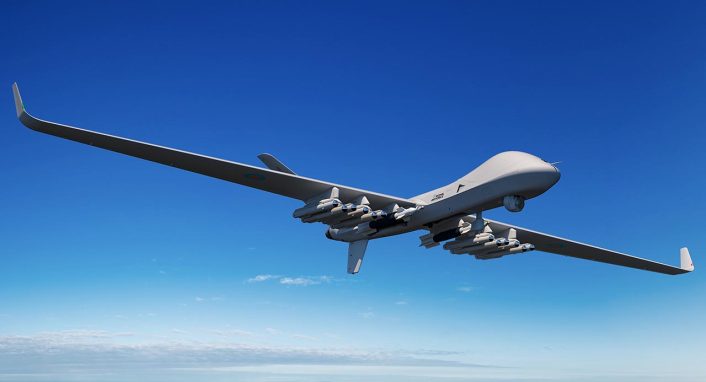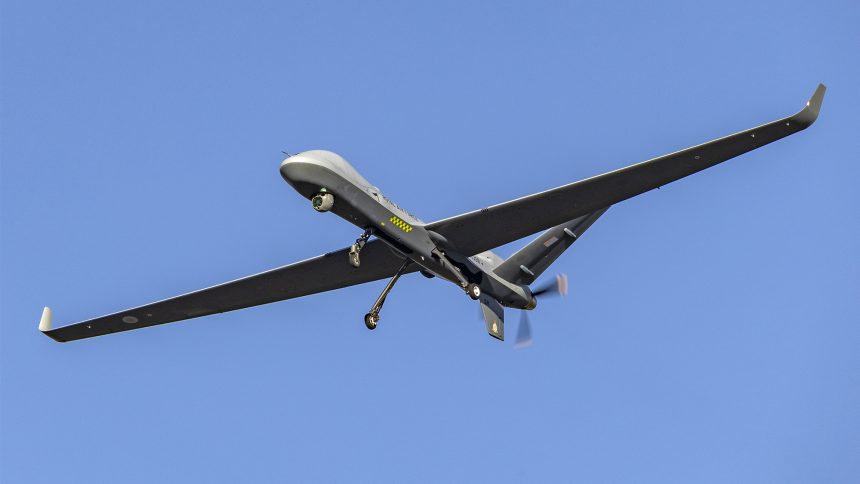The UK Military Aviation Authority issued a Military Type Certificate for the RAF’s MQ-9B Protector RG1, clearing the aircraft for flight in regular airspace.
General Atomics Aeronautical Systems Inc (GA-ASI) announced on May 8, 2025, that their MQ-9B aircraft, designated Protector RG1 in UK service, had successfully passed the airworthiness assessments that will clear it for operational service and remove the requirement to only fly in specially restricted airspace. The news follows a series of short flight tests commencing in February 2025 using airspace around home base RAF Waddington.
The company also confirmed that 10 of the Royal Air Force’s 16 ordered airframes have now been delivered. This is an important milestone as the UK Government recently confirmed its intention to withdraw their existing MQ-9A Reaper fleet by the end of 2025. It is unclear how many Protector airframes are physically present at RAF Waddington. Although Waddington is also nominally the home base for the Reaper fleet, and the location of the RAF’s Ground Control Stations (GCS), all known Reaper operations have been conducted from remote overseas locations.

GA-ASI Chief Executive Officer Linden Blue said “Earning an MTC [Military Type Certificate] for MQ-9B was a herculean effort and a seminal achievement for our company.” He added that, using three flight test airframes and one ground test airframes, the certification process had simulated 120,000 hours of aircraft operation generating over 140,000 pages of detailed technical data.
The most recent UK flight tests involving the Protector took place on May 7 and May 8. These tests were the longest duration and distance so far, and were almost certainly part of the final check for this certification. Taking off from RAF Waddington on May 7, the first flight, as PHOENIX 55, saw the aircraft climb to above 10,000 feet before orbiting near the airfield. The following day, PHOENIX 57 left the confines of RAF Waddington and made the short flight to RAF Marham, before taking off again and returning to Waddington shortly after.
Notably, the journey to RAF Marham took place at 21,000 feet, placing the aircraft in airspace that would usually be shared with commercial air traffic. On this occasion, as the aircraft had yet to receive its final certification, other air traffic was visibly kept well clear.

The UK, as the aircraft’s effective launch customer, is the first nation to certify the MQ-9B with an MTC. Belgium, Canada, Poland, Japan, Taiwan, India, and the U.S. have also placed orders for the new drone. The MQ-9B was designed specifically to meet the requirements of NATO Standardized Agreement 4671 (STANAG 4671) which will likely simplify further certification processes in other NATO member states, as well as NATO allies who follow STANAG practices.
MQ-9B SkyGuardian® is the world’s most advanced remotely piloted aircraft system and will soon deliver long endurance and advanced ISR for the @BelgiumDefence. With first flight recently completed, Belgium is among a growing list of MQ-9B SkyGuardian® / SeaGuardian® customers… pic.twitter.com/78AW4qNUs8
— General Atomics Aeronautical Systems, Inc (GA-ASI) (@GenAtomics_ASI) April 22, 2025
To ensure it meets the strict requirements of operating in standard airspace alongside other air traffic, the MQ-9B boasts a number of features uncommon for other unmanned aircraft of its size. This includes lightning and fire protection systems, and anti-icing equipment, while rigid separation is maintained between mission systems and flight critical software.
“Achieving the award of a first in class Military Type Certificate has required years of dedication and perseverance and is a testament to the hard work of all involved. It is a privilege to be the first to be awarded an MTC for the Protector Air System,” remarked RAF Group Captain Neil Venables of the Type Airworthiness Authority.
Clearance to fly in regular airspace will afford Protector RG1 with increased versatility, allowing its participation in training exercises over the UK as well as potential operational missions under the Military Aid to Civil Authorities (MACA) system. MACA allows civilian agencies to call upon military support to assist in responses to emergency situations including evacuations, natural disasters, and terrorist incidents. The Protector’s intelligence, surveillance, and reconnaissance (ISR) suite would provide an excellent capability monitoring the effects of a natural disaster or assisting in search and rescue (SAR) operations.
Weapons Integration
The primary weapons employed by the RAF Reaper fleet in current operations are the GBU-12 Paveway II precision guided bomb and the AGM-114 Hellfire missile. Freedom of information act requests have revealed the Hellfire variants utilized include the AGM-114N4, fitted with a metal augmented charge ‘thermobaric’ warhead, and the AGM-114R2 with a multi-purpose low collateral damage warhead.
According to the Royal Air Force, the Protector RG1 will replace the Paveway II with the upgraded Paveway IV – which has already seen extensive service on the Typhoon FGR4 and F-35B Lightning II. Paveway IV is a UK developed dual mode laser and GPS/INS guided weapon based on the unguided Mark 82 500 lb bomb. It has been operated by the RAF since 2008 and is also in service with the Royal Saudi Air Force.
Royal Air Force Typhoon FGR4 on 22nd February 2024 having Paveway IV weapons loaded by Weapon Technicians in support of current ongoing operations pic.twitter.com/k7SFphItul
— Think Defence (@thinkdefence) June 2, 2024
Protector will also carry the UK’s famed Brimstone missile in its latest Brimstone 3 guise. Using triple ejector racks, three Brimstone missiles can be carried on each of the aircraft’s six hardpoints, offering a theoretical maximum capacity of 18 missiles. The missile was recently confirmed to be scheduled for integration on Protector in Q4 of 2025, and on Typhoon in Q4 of 2026.
Brimstone 3 features an improved multi-function warhead alongside upgrades to the autopilot, navigation systems, and battery energy storage. It also provides for an integrated surface-to-surface engagement capability. It will be guided by the same dual-mode laser and millimeter wave active radar seeker system as Dual Mode Brimstone and Brimstone 2.

Protector will almost certainly, in due course, also be outfitted to carry the variety of ISR payloads that can be attached to the Reaper. These will expand upon the aircraft’s existing electro-optical/infrared (EO/IR) and synthetic aperture radar sensors. Very little has been publicly acknowledged about these add-on capabilities for the Reaper, but they have been shown in a number of official and unofficial images of USAF and RAF aircraft.









